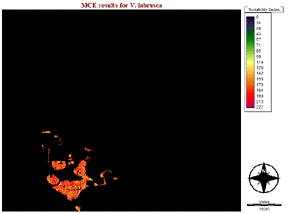Spatial Analysis
The images produced from the Decision Wizard MCE provided a suitability index of values from 0-255. These values were reclassed into 5 classes. The following images show the results of the MCE as well as the new classes reclassed through the module Reclass.
Vitis labrusca
It is clear from these images that this wine grape species had a high potential to survive in the GVRD. Most of the zones in the location they can be found is considered to be of highest suitability. The outcome from the Area module was:

These results shows that a large portion of the GVRD could sustain the grape V. labrusca.
Vitis vinifera
V. vinifera appears to have a similar total area to V. labrusca although a large portion of its area is only low to medium suitability. There are some locations that have high suitability, but compared to V. labrusca it is a relatively small amount. The outcome for the Area module was:

The area for V. vinifera is clearly very differently distributed than V. labrusca. There is only 590.6 acres that aremost suitable for V. vinifera while there is 4790.7 acres in V. labrusca. This value is almost ten times the size.
Vitis riparia
The suitability of V. riparia is very low for the GVRD. Any areas that are suitable are considerably smaller in size than in the other two grape species. While a large portion of each area is classified as highly suitable, the overall area is too small to support the potential for V. riparia viticulture in the GVRD. The outcome from the Area module is:

The results from this calculation supports the results above. It is clear that V. riparia is not a likely candidate for large scale viticulture in the GVRD. Although, V. riparia is highly suitable in the locations it can survive, and therefore there is a potential for smaller scale viticulture. This would largely be beneficial because V. riparia produces rarer wines and therefore would be economically more beneficial then the other two very common grape species analysed.





